Overview
This article dives into some essential B2B UX design strategies that are tailor-made for equipment manufacturers. Have you ever thought about how crucial it is to adapt user experiences to boost online sales and improve customer interactions? Well, it turns out that effective strategies—like understanding those complex workflows, doing user research, and setting up clear information architecture—play a big role in enhancing usability and customer satisfaction. And guess what? This ultimately leads to business success in a competitive landscape. So, let's explore these strategies together and see how they can make a real difference!
Introduction
In today’s fast-paced digital world, equipment manufacturers are navigating some pretty unique challenges that can really affect their success. You know, effective B2B UX design has become a game-changer for boosting online sales and improving customer interactions. Yet, many companies find it tough to keep up with what modern users expect. So, how can manufacturers tap into strategic design principles to not just meet but exceed the diverse needs of their clientele? In this article, we’ll explore ten essential B2B UX design strategies specifically crafted for equipment manufacturers. These insights could truly transform your digital presence and spark growth!
GenAlpha Technologies: Elevating B2B UX Design for Manufacturers
GenAlpha Technologies is really shaking things up in the world of B2B UX design, particularly for producers. Have you ever thought about the unique challenges equipment producers and distributors face? GenAlpha gets it, and they’re using their industry know-how to craft digital solutions that seriously boost online sales and customer interactions. Their flagship product, Equip360, is a perfect example of this commitment. It optimizes inventory management and ramps up digital sales performance, making it easier for producers to offer a seamless purchasing experience. And here's a fun fact: 80% of B2B purchases are influenced by B2B UX design rather than just cost or product features, according to Enrique Jose Tabuena.
In today’s competitive landscape, it’s clear that a B2B website that doesn’t adapt is just waiting to be replaced. The ability to deliver an intuitive and engaging user experience is crucial for producers who want to thrive in B2B UX design within the digital world. Plus, with over 1,800 manufacturers having folded in the last year and a half, the need for effective B2B UX design strategies has never been more urgent. So, what are you waiting for? It's time to rethink your approach and embrace the digital transformation!
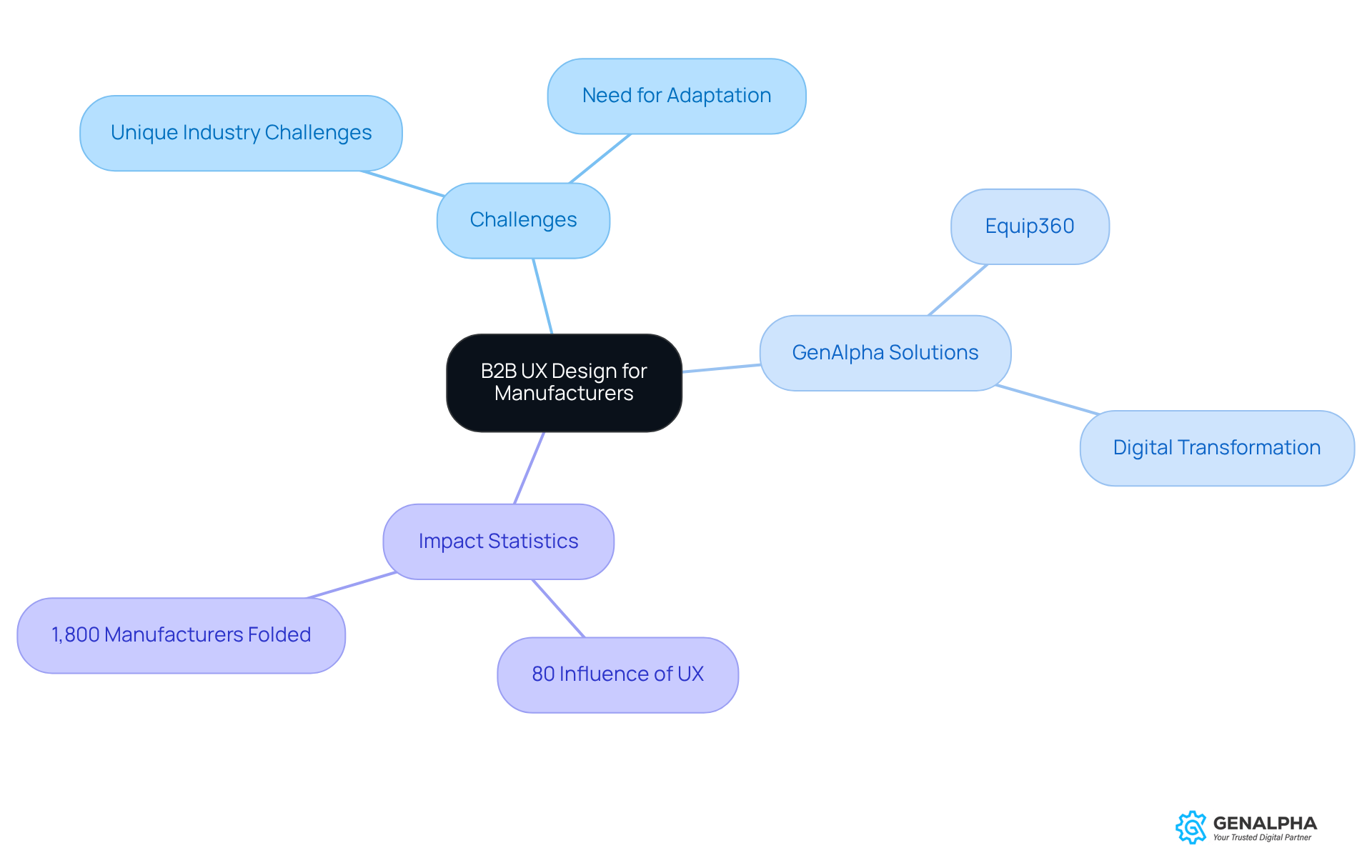
Understand Complex Workflows: Tailoring UX for B2B Environments
In B2B settings, workflows can get pretty complex, right? That's why a careful approach to B2B UX design is so important. To create an effective UX, we need to map out these workflows meticulously and understand what individuals need at each stage. This means identifying pain points and streamlining processes to make things smoother. For example, did you know that ILRES saw a 30% rise in conversions after redesigning their interface? That really shows the concrete benefits of a customized UX!
By incorporating client feedback into the creation process, producers can develop solutions that not only meet but anticipate client needs. This ultimately leads to a more productive and engaging experience. As Sebastian Burton, Marketing Director at Engel & Völkers Atlanta, puts it, "MediaMagic and their team are my constant resource for running razor-sharp campaigns." This highlights just how crucial effective B2B UX design is for achieving business success.
So, how do we start charting workflows? It’s simple! Manufacturers should engage with their clients through surveys and interviews. This ensures that the UX layout aligns perfectly with their operational realities. What do you think? Are you ready to dive into creating a better UX?

Conduct User Research: The Foundation of Effective B2B UX Design
Have you ever thought about how crucial user research is for creating great b2b ux design? Engaging with end-users is a fantastic way to gather insights into their experiences, preferences, and challenges. Methods like surveys, interviews, and usability testing can provide valuable data that really guides development choices.
When we understand the client’s viewpoint, we can create b2b ux design solutions that effectively meet their needs. This not only leads to enhanced satisfaction but also fosters loyalty. So, next time you’re working on a project, consider diving deep into user research—it could make all the difference!
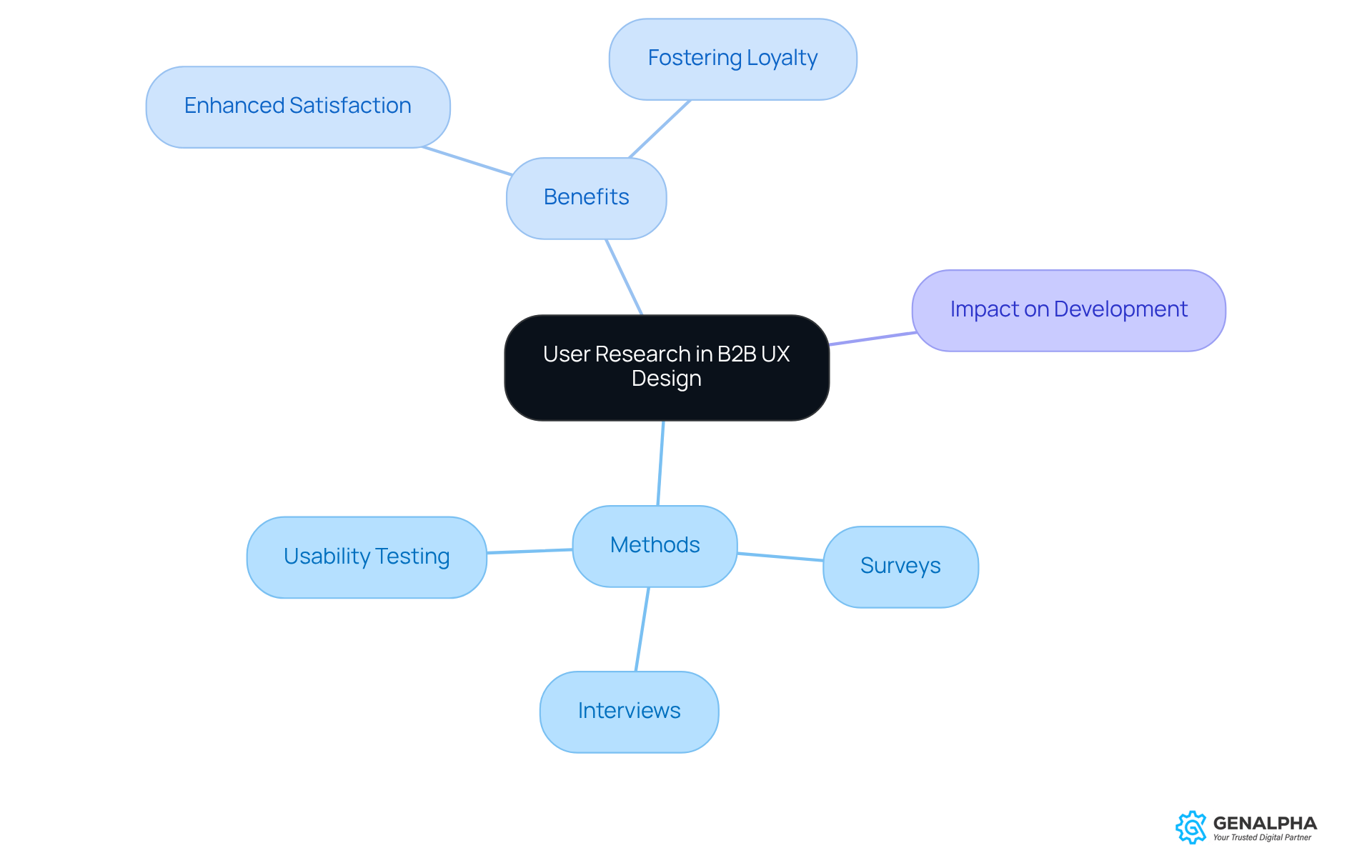
Design for Multiple Stakeholders: Catering to Diverse User Needs
In the B2B world, have you ever noticed how products and services are influenced by a variety of stakeholders, each with their own unique needs and expectations, which emphasizes the importance of B2B UX design? It’s crucial for effective B2B UX design to consider these diverse roles—think procurement officers and technical staff. By developing customer personas and outlining what each group specifically needs, manufacturers can create solutions that truly resonate with everyone involved. This way, we can ensure a more thorough and fulfilling interaction for all. How can we make this process even better?
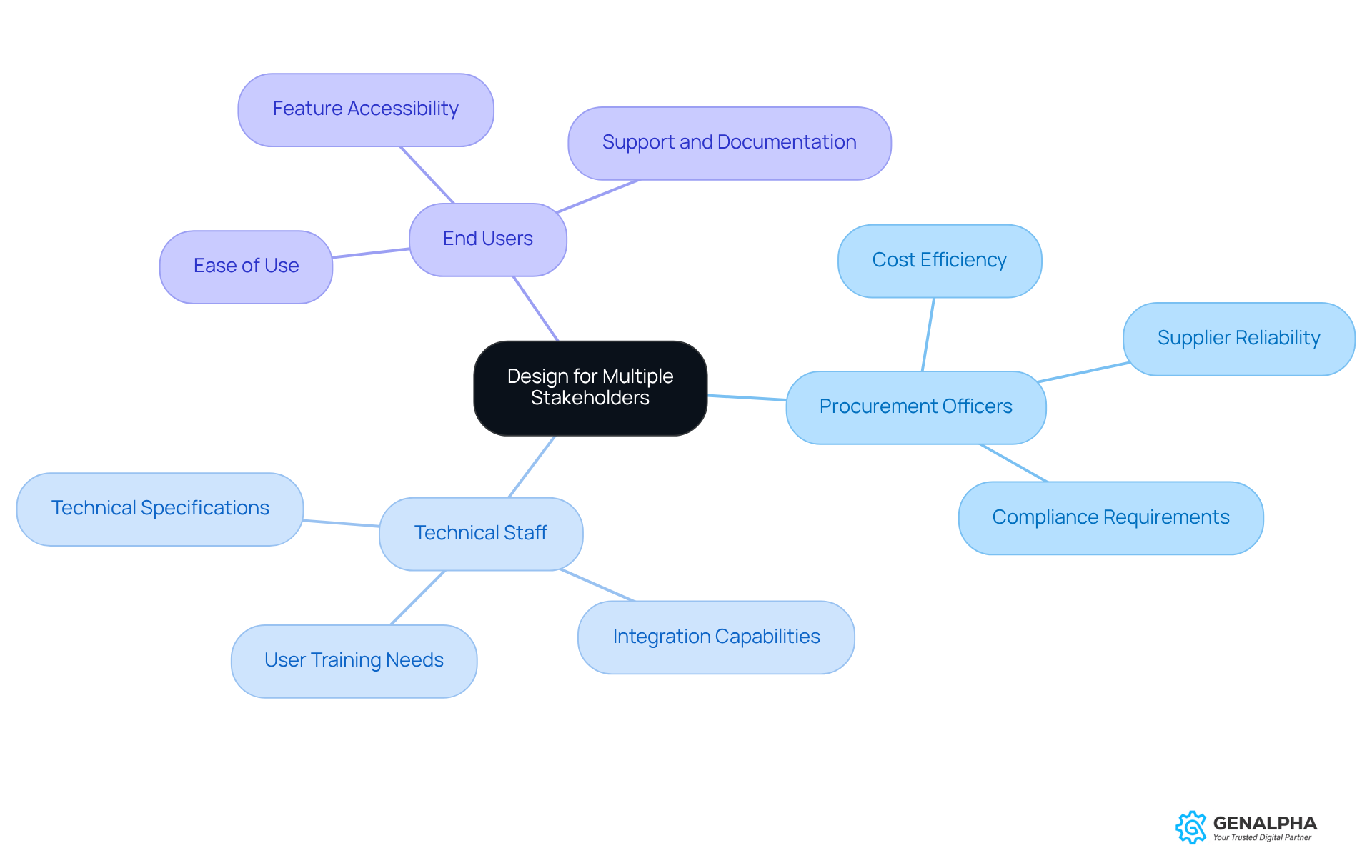
Implement Clear Information Architecture: Enhancing Usability in B2B UX
Creating a clear information structure is super important for improving B2B UX design and making B2B interactions easier and more user-friendly. Think about it: when content and features are organized thoughtfully, it allows people to navigate the platform without any hassle. By using intuitive labels, effective categories, and strong search functions, manufacturers can really boost the user experience. Did you know that studies show platforms with well-organized information architecture see a significant rise in usability? Users report up to a 50% decrease in the time they spend looking for information! This smoother navigation not only cuts down on frustration but also increases overall satisfaction, leading to a more engaging and efficient interaction with the platform.
For instance, manufacturers who have embraced clear content organization strategies have seen better customer retention rates and increased sales efficiency. This really highlights the tangible benefits of prioritizing usability in their B2B UX design solutions. As Frank Chimero wisely said, "People overlook aesthetics that overlook individuals," which emphasizes the need for user-centric approaches in our creations. Additionally, a case study on customer-focused structure shows that companies focusing on clear information organization can create more effective and engaging interactions, ultimately leading to improved business outcomes.
So, how can you start prioritizing usability in your own digital solutions?

Prioritize Usability Over Aesthetics: Focusing on Functionality
You know, while aesthetics can definitely enhance interaction quality, it’s crucial to prioritize usability in the context of B2B UX design. Imagine navigating a complex interface that looks great but leaves you scratching your head—frustrating, right? Manufacturers really should aim for creating intuitive and easy-to-use interfaces, even if it means giving up a bit of that visual flair. This approach ensures that everyone can get their tasks done efficiently, leading to happier users and cutting down training time for newcomers. So, let’s focus on what truly matters: making things simple and effective!

Leverage Analytics: Driving Continuous Improvement in B2B UX
Harnessing analytics is key to enhancing the B2B UX design for the client experience. Imagine being able to pinpoint exactly where your interactions could use a little boost! By carefully tracking behaviors and interactions, manufacturers can identify those sweet spots that are just waiting for enhancement and make smart, data-driven design choices.
Tools like heatmaps show where users are most engaged, flow analysis maps out their journey through your platform, and conversion tracking helps you see how effective your calls to action really are. These insights into engagement patterns are invaluable. For instance, Contentsquare's AI-driven insights can uncover friction points and technical hiccups, highlighting just how important robust analytics tools are.
And let’s not forget about Microsoft Clarity, which offers a free option for basic analytics—perfect for producers eager to refine their platforms. This ongoing, iterative approach means you can continually enhance your platform, ultimately leading to better user experience through B2B UX design and happier clients.
However, it’s important to recognize that 67% of analytics leaders believe that organizational culture is the biggest hurdle to becoming a data-driven organization. This statistic really underscores the challenges companies face when trying to adopt these crucial tools. So, what do you think? Are you ready to tackle these analytics challenges head-on?

Adopt Modular Design Approaches: Flexibility in B2B UX Solutions
Have you ever thought about how modular design strategies can really shake things up in b2b ux design solutions? Imagine creating elements that can be easily rearranged or updated. This flexibility allows manufacturers to quickly adapt to changing consumer needs and market trends. Not only does this boost user satisfaction, but it also makes updates and maintenance a breeze, leading to a more resilient platform.
Research shows that well-optimized products can achieve task success rates over 90%. Plus, modular construction can extend product life by more than 50%. Companies that focus on adaptable solutions in b2b ux design are in a better position to respond to the rapid changes in the digital landscape, keeping them competitive and relevant.
Jake Davis, Design Director at Pocket App Ltd, highlights how crucial it is to adopt a user-centric design approach to effectively integrate these trends. And here’s a thought: improving UX to increase customer retention by just 5% can boost profits by 25% or more. That’s a significant financial incentive for embracing adaptability!
Take the JobNimbus UX redesign, for instance. It saw its rating soar from 2.5 to 4.8 stars, demonstrating the powerful impact of a customer-focused approach. So, how can you start implementing these strategies in your own work?

Ensure Smooth Onboarding: Enhancing User Experience from the Start
A smooth onboarding process is crucial for boosting satisfaction right from the start. Have you ever felt lost when trying to figure out a new platform? Manufacturers should really focus on offering thorough guidance—think tutorials and ongoing support—to help new users navigate with ease. Investing in solid onboarding procedures can significantly reduce the learning curve. In fact, organizations with strong onboarding practices can boost new hire retention by a whopping 82% and productivity by over 70%!
But that’s not all. Statistics reveal that employees who experience great onboarding are 3.3 times more likely to feel their job meets or exceeds expectations. And here’s something to think about: 86% of customers say they would remain loyal if they had a successful onboarding experience. By putting structured onboarding strategies in place—like personalized messaging and interactive training—and recognizing the three stages of onboarding—primary, secondary, and tertiary—manufacturers can truly enhance client experiences and build lasting relationships.
As Emilia Korczynska, Head of Marketing, puts it, "The more excitement you create during customer onboarding, the more loyalty you’ll win." So, let’s make onboarding an exciting journey together!
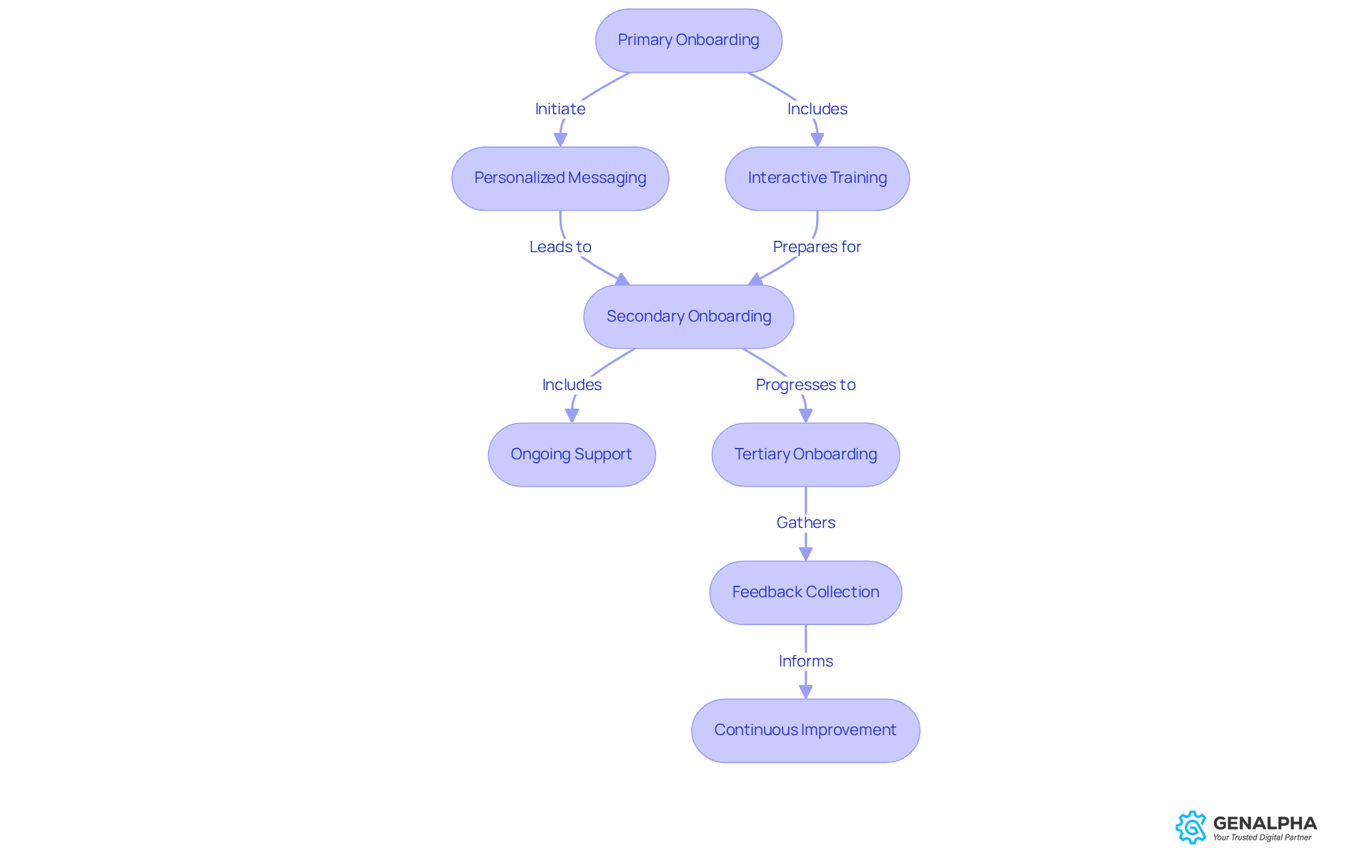
Embrace Continuous Testing and Iteration: Adapting to User Feedback
Embracing continuous testing and iteration is crucial for adapting B2B UX to meet the ever-changing needs of clients. Have you ever thought about how manufacturers can tap into consumer feedback? Regularly seeking input and conducting usability tests can help identify areas for enhancement. By adopting an agile design approach, companies can make iterative changes that genuinely improve user experiences, ensuring their solutions stay relevant and effective in a fast-paced marketplace.
High-performing teams really shine when they leverage insights from UX testing to make real-time adjustments. They treat data as a living feedback mechanism. As Scott puts it, "What separates high-converting teams is how fast they act on the insights these tests derive." This proactive stance not only boosts customer satisfaction but also drives measurable improvements in business performance.
Now, consider this: 91% of unsatisfied customers don’t voice their complaints. This makes the need for continuous testing even more critical. Investing in UX can yield significant returns; in fact, every dollar spent can result in a whopping return of $100. This really underscores the financial impact of prioritizing user feedback and agile methodologies. So, why not take that leap and start embracing continuous testing today?
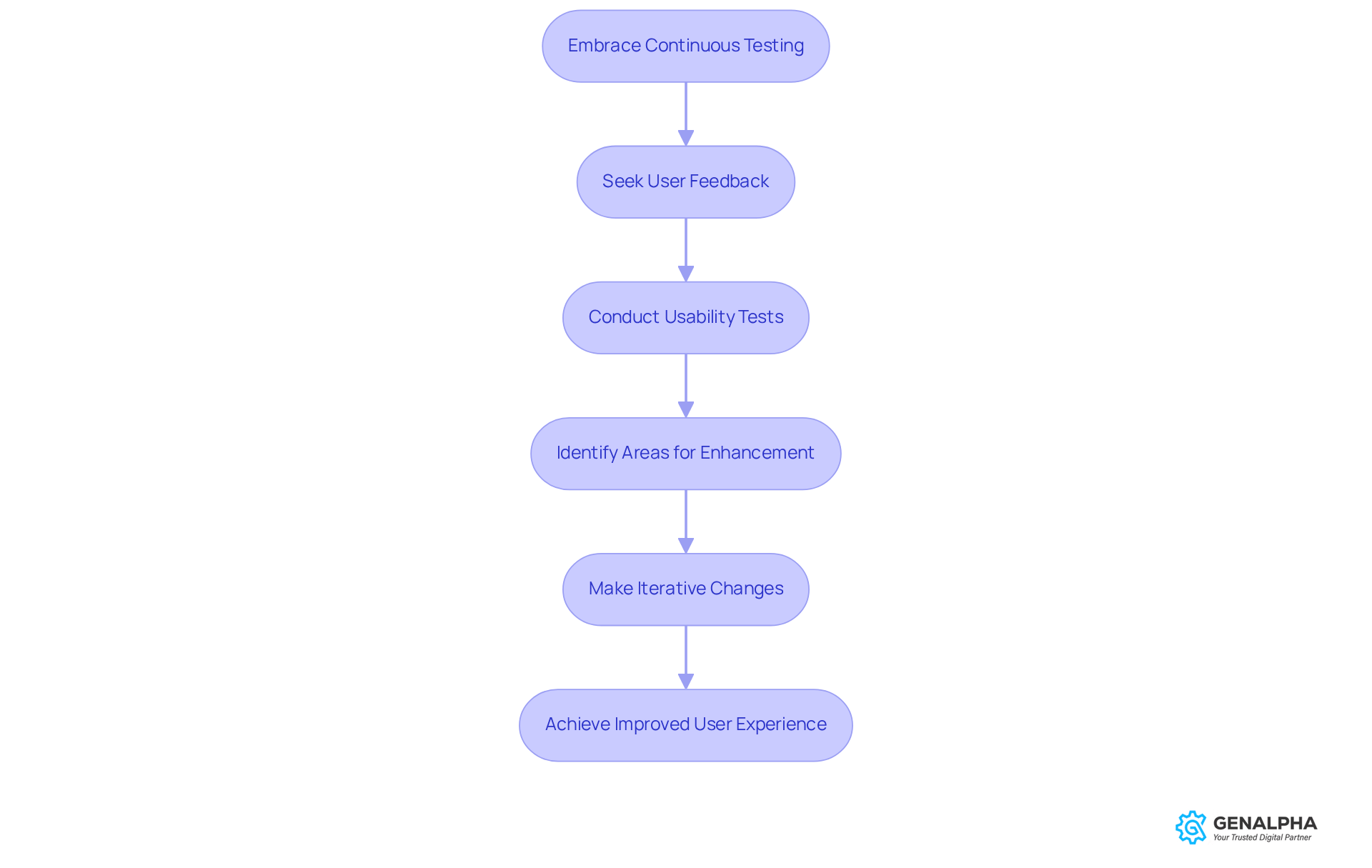
Conclusion
In the world of equipment manufacturing, we can't overlook the importance of effective B2B UX design. Think about it: as we've explored in this article, manufacturers need to keep up with the ever-changing digital landscape by putting user experience front and center. By embracing tailored design strategies, companies can not only improve customer interactions but also boost sales and enhance overall satisfaction.
So, what are some key strategies? Well, understanding complex workflows, conducting thorough user research, and designing for multiple stakeholders are crucial. Each of these approaches helps create an intuitive and engaging user experience. Plus, by implementing clear information architecture and prioritizing usability over aesthetics, we can significantly improve platform navigation, making it easier for users to achieve their goals.
Ultimately, the message is clear: manufacturers must commit to continuous testing and iteration, using analytics to fine-tune their UX strategies. By doing this, they can stay competitive and responsive to their clients' needs, fostering loyalty and driving business success. The journey toward exceptional B2B UX design is ongoing, and the time to act is now. What steps will you take to enhance your user experience today?
Frequently Asked Questions
What is GenAlpha Technologies known for?
GenAlpha Technologies specializes in B2B UX design, particularly for manufacturers, creating digital solutions that enhance online sales and customer interactions.
What is Equip360 and how does it benefit manufacturers?
Equip360 is GenAlpha’s flagship product that optimizes inventory management and improves digital sales performance, facilitating a seamless purchasing experience for producers.
How significant is B2B UX design in influencing purchasing decisions?
According to Enrique Jose Tabuena, 80% of B2B purchases are influenced by B2B UX design rather than solely by cost or product features.
Why is effective B2B UX design crucial for manufacturers today?
Effective B2B UX design is essential for manufacturers to thrive in a competitive landscape, especially as over 1,800 manufacturers have closed in the past year and a half, highlighting the urgent need for effective strategies.
What approach should be taken to tailor UX for B2B environments?
A careful approach involves mapping out complex workflows, identifying pain points, and streamlining processes to create a smoother user experience.
Can you provide an example of the benefits of customized UX design?
ILRES experienced a 30% increase in conversions after redesigning their interface, demonstrating the tangible benefits of a tailored UX.
How can manufacturers gather feedback to improve their UX design?
Manufacturers should engage clients through surveys and interviews to ensure the UX layout aligns with their operational needs.
What role does user research play in B2B UX design?
User research is vital for understanding end-users' experiences, preferences, and challenges, which helps create solutions that meet their needs and foster loyalty.
What methods can be used to conduct user research?
Methods such as surveys, interviews, and usability testing can provide valuable insights that guide development choices in B2B UX design.




